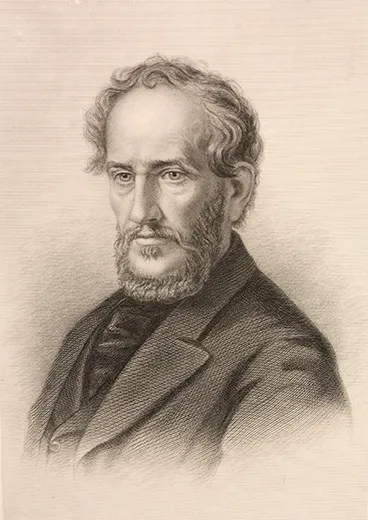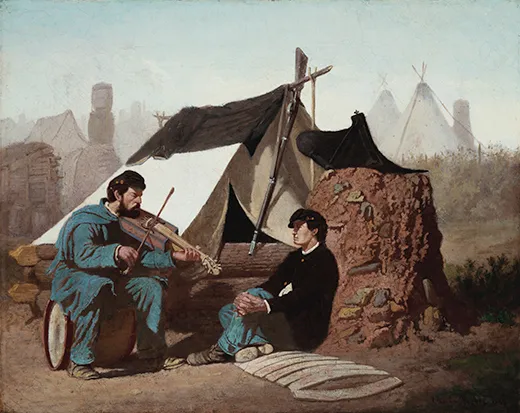The Sentimental Ballad of the Civil War
Forget “Dixie,” it was one New Yorker’s “Home Sweet Home” that was the song most beloved by Union and Confederate soldiers
/https://tf-cmsv2-smithsonianmag-media.s3.amazonaws.com/filer/Civil-War-soldiers-music-631.jpg)
When folk musician Tom Jolin performs Civil War songs in concert, it’s not “When Johnny Comes Marching Home,” “The Battle Cry of Freedom” or any of the other standards of that time that really tugs his heartstrings. Rather, it is a piece written in 1822 by a talented American who was already nine years in his grave by the time the first shots were fired at Fort Sumter.
The song is “Home, Sweet Home!” by John Howard Payne.
“It gets me every time,” admits Jolin, who plays banjo, harmonica and dulcimer. “I’m such a sucker for sentimentality.”
Indeed, Payne’s plaintive refrain “there’s no place like home” does not arouse martial instincts. There are several accounts of Confederate and Union troops camped near one another, perhaps just across a river, the night before or after combat, harmonizing “Home, Sweet Home!” across the battle lines. Eventually the Union authorities prohibited the regimental bands from playing the song fearing it might make the soldiers too homesick to fight.
Abraham Lincoln himself was a great admirer of the song. When Italian Opera star Adelina Patti performed at the White House in 1862, she noticed Mary Todd Lincoln—still mourning the death of their 12-year-old son, Willie, from typhoid fever—crying during the performance and the President holding his hands over his face. When Patti offered to sing another tune, Lincoln requested “Home, Sweet Home!” It was, he told her, the only song that could bring them solace.
Sadly it did little for the man who wrote it. Born in New York in 1791, Payne was a precocious talent, an intimate to some of the greatest creative minds of his age, a wanderer and a fellow with a knack for bad money management. The son of a schoolmaster, he showed great promise performing in school productions but was dissuaded from the theater—hardly a respectable profession in those days—by his father. Instead, he was sent to work as a clerk in an accounting firm, where he managed to find time to create a newspaper devoted to the theater. Published anonymously (who would take a 14-year-old seriously as a drama critic?), The Thespian Mirror made a big impact in the theater community and set Payne on the road to a career as a writer and performer.
In 1813, he arrived in London, sent there through the largesse of friends eager to help further his promising theatrical career. He earned rave reviews for his performances at the famous Drury Lane Theatre. “Nature has endowed him every quality for a great actor,” wrote one reviewer. The handsome young man went on to play the starring role in Romeo and Juliet and is believed to be the first American actor to play Hamlet. Payne was also writing, adapting and producing plays. An unsuccessful attempt at managing a theater house landed him in debtor’s prison for a year. Once released he worked with Covent Garden Theatre manager and actor Charles Kemble to transform a play into an operetta by altering the plot and adding songs and duets. Clari, or the Maid of Milan, debuted in London in 1823. The show’s climatic number was “Home, Sweet Home!” sung by the title character, a poor maiden who has become embroiled in a relationship with a nobleman. When the nobleman reneges on his promise of marriage, Clari, surrounded by the trappings of palatial life, longs for the humble but wholesome home she was duped into leaving.
According to Gabriel Harrison, Payne’s 19th-century biographer, the song “at once became so popular that it was heard everywhere.” More than 100,000 copies were printed in less than a year, netting huge profits for the publisher. “Still,” writes Harrison, “with all the success of the opera and the publication of the song, Mr. Payne was the least benefited of all concerned.”
Copyright laws were practically nonexistent in those days, and Payne saw little money from “Home, Sweet Home!” in either Europe or America. He “suffered financial difficulties his entire life,” says Hugh King, director of a museum dedicated to Payne in East Hampton, New York.
“He was a poor money manager.”
Despite financial setbacks, Payne’s career flourished in Europe. He would write more than 60 theatrical works, mostly adaptations, while becoming friends with prominent visiting or expatriate Americans such as Washington Irving and Benjamin West. He acted with Edgar Allan Poe’s mother and unsuccessfully tried to court Mary Shelley, author of Frankenstein. When Payne returned to the States, he traveled the country with John James Audubon, becoming a champion of Cherokee Indian issues.
Eventually, through political connections, Payne was appointed to an unlikely position: He became consular general to Tunis in 1842. There he died in 1852. Some of his effects were auctioned off to pay his debts.
A decade later, in the midst of the Civil War, his most famous song enjoyed a resurgence. “It held extreme emotional power,” says Jolin, who frequently includes “Home, Sweet Home!” in the 35 concerts he gives every year at Gettysburg National Military Park. “The soldiers were in such adverse conditions, they longed for the serenity and warmth of their homes.”
While the brass bands that were an integral part of both armies would have played the song, Jolin believes its most moving renderings would have been on the harmonica, played around campfires, perhaps accompanying the soldiers’ voices. “A harmonica has a sweet tremolo,” he says. “It would have been well suited to the sentimentality of the song.”
“Home, Sweet Home!” continued to be a popular song for decades after the war. So why is it barely remembered today?
“Sentimental ballads went out of style,” explains Todd Cranson, a music professor at Henderson State University in Arkadelphia, Arkansas. “During World War I, when people began playing and singing songs that had been popular during Civil War times—which was still in living memory at that point—the ones they preferred were the more up-tempo, martial ones.”
While most Americans today can probably sing along to the chorus of “When Johnny Comes Marching Home,” modern audiences find the nostalgic strains of “Home, Sweet Home!” a bit over the top. That, however, doesn’t diminish the historic significance of the song. It lives on in the music of people like Jolin as well as in an 18th-century saltbox-style house in the resort town of East Hampton. Promoted as the home of Payne, the house was opened to the public in 1928.
“Unfortunately, what people were learning then was wrong,” explains King, director of the house museum. Though Payne’s relatives had once lived in the house and he had probably visited there as a child, there is no evidence to suggest that he had that particular house in mind when he wrote the famous song. Even so, the museum’s serene gardens and nearby windmill are idyllic, conjuring an image of family and hearth—emotions captured and expressed by Payne, a gifted American who found his home in many places around the world.

